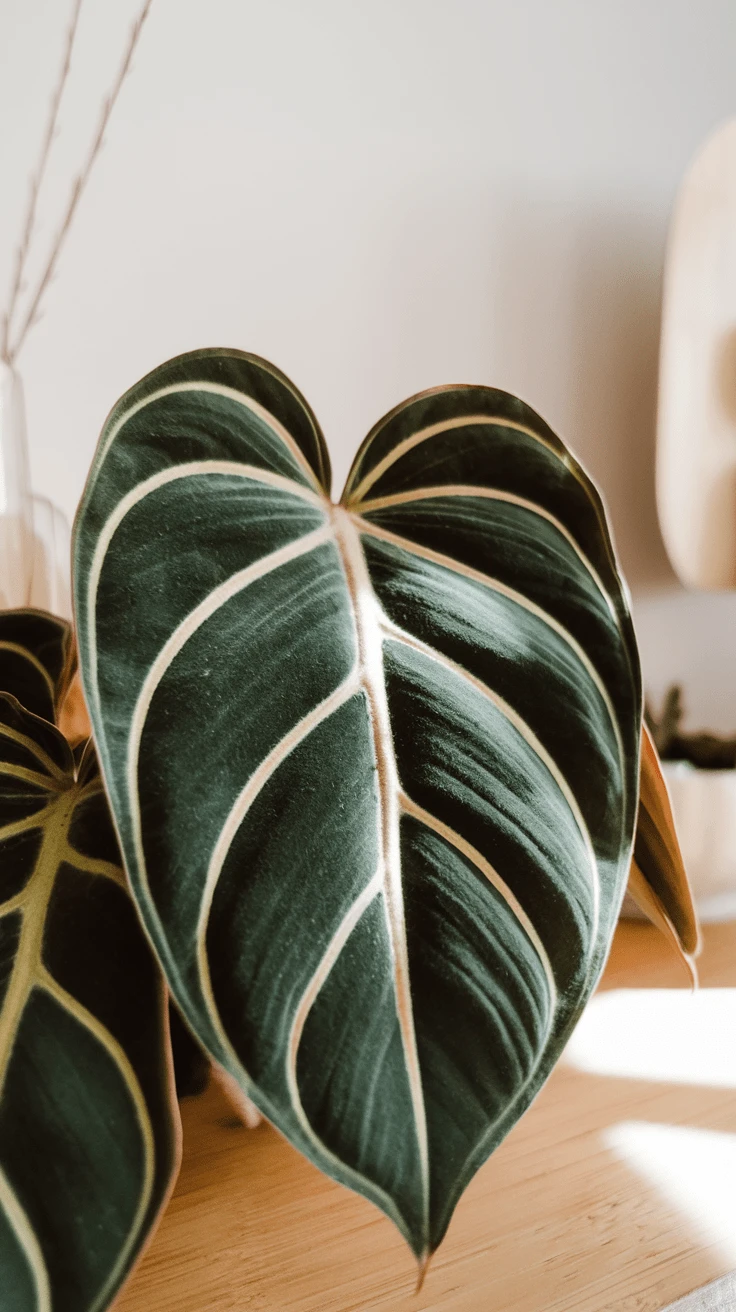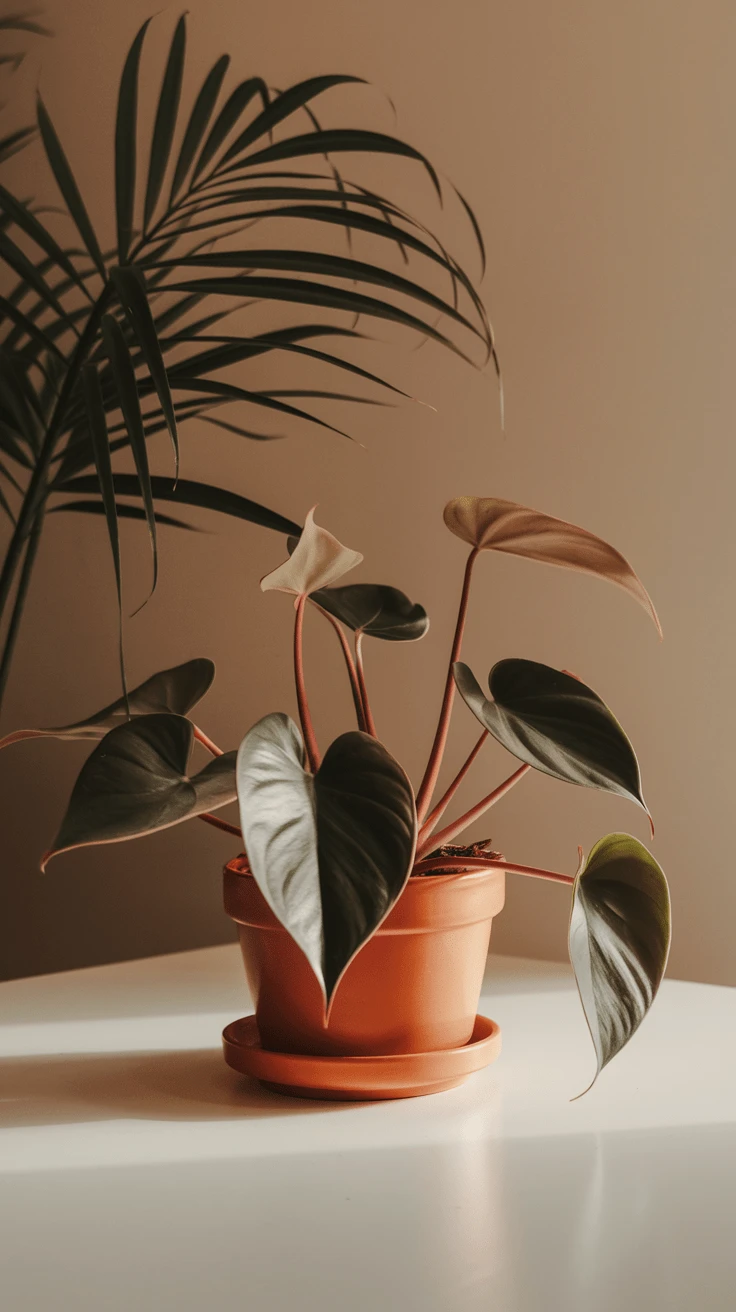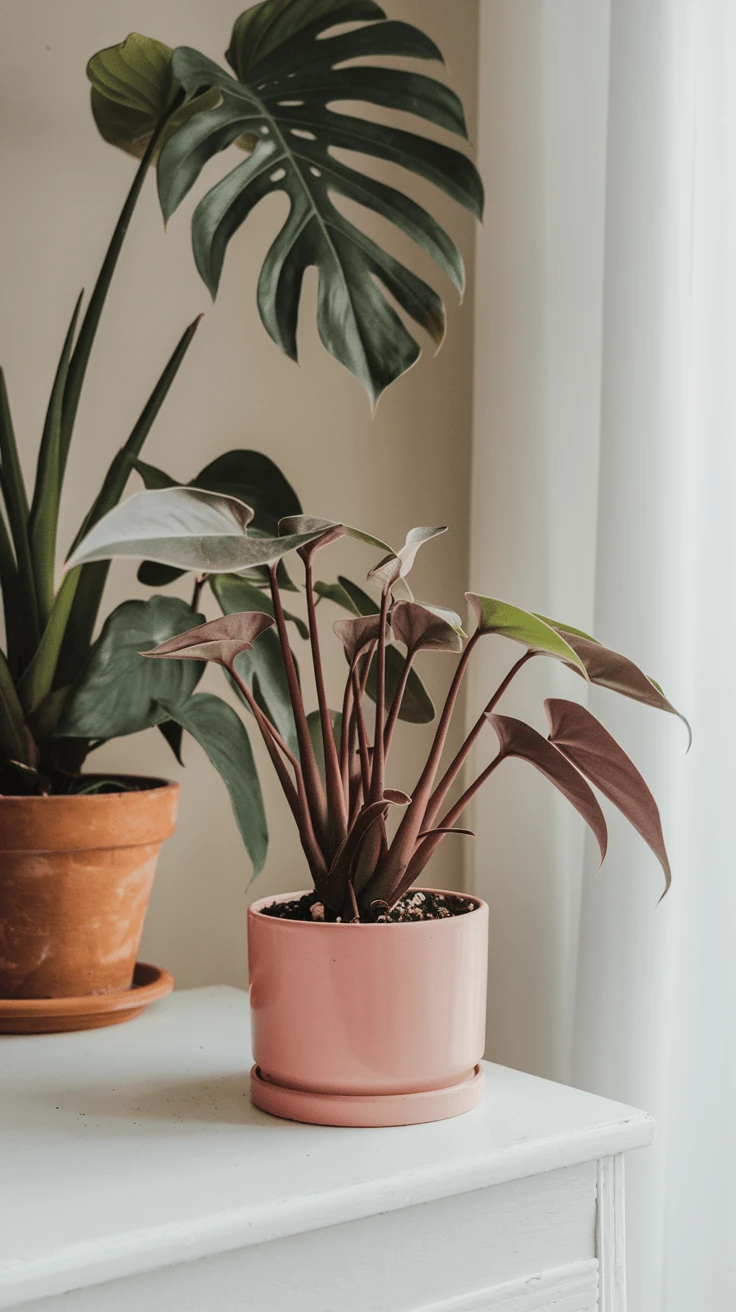Biological Features of Philodendron Melanochrysum

Philodendron Melanochrysum is a stunning species native to tropical regions, characterized by its glossy, heart-shaped leaves. Notably, these leaves can grow quite large, often reaching lengths of up to 18 inches. Furthermore, they display a striking dark green color, which transforms into a beautiful, reflective hue when exposed to sunlight. Additionally, the undersides of the leaves have a reddish tint, which further adds to the overall aesthetic appeal.
This plant is a climbing variety, known for its ability to scale trees or support structures in its natural habitat. It effectively uses aerial roots to anchor itself. With the proper support, the plant can grow quite tall, sometimes even exceeding several feet.
Although the flowers of Philodendron Melanochrysum are less notable than the leaves, they can still be a fascinating aspect of its biology. They emerge infrequently and are typically cream to yellow in color. Additionally, this plant is known to produce fruit, though it is a rare occurrence in cultivation.
| Feature | Description |
|---|---|
| Leaf Size | Up to 18 inches long |
| Leaf Color | Dark green with reddish undersides |
| Climbing Ability | Uses aerial roots |
| Flower Color | Cream to yellow |
| Growth Habit | Tall, climbing |
Overall, Philodendron Melanochrysum is an exceptional choice for indoor plants. Its dramatic foliage truly makes it a standout in any collection. To thrive, however, it requires adequate light and humidity, reflecting its tropical origins.
History and Cultural Significance
Philodendron Melanochrysum is admired not only for its striking appearance but also for its unique growth patterns. This tropical plant originates from South America, particularly in regions like Colombia and Ecuador. Interestingly, its name is derived from Greek, where ‘philo’ means ‘love’ and ‘dendron’ means ‘tree,’ suggesting its natural affinity for tree-like growth.
Culturally, Philodendron Melanochrysum holds significance in various indigenous traditions, symbolizing prosperity and harmony. Furthermore, the plant’s lush foliage is often used to enhance indoor spaces, representing nature’s inherent beauty.
Throughout history, Philodendron species have been popular in traditional medicine. Indigenous communities valued their properties for various health benefits, although scientific validation of these uses remains limited. In fact, the leaves were sometimes used in poultices and herbal remedies.
Today, Philodendron Melanochrysum is widely cultivated for ornamental purposes. Since it thrives in humid environments, it can now be found in homes and botanical gardens worldwide. Enthusiasts appreciate this plant not only for its elegant appearance but also for its low maintenance needs.
- Originally from the South American tropics.
- Symbolizes prosperity in indigenous cultures.
- Historically used in traditional medicine practices.
- Widely popular as an ornamental plant in homes.
- Thrives in high humidity and indirect light conditions.

Ideal Growing Conditions for Philodendron Melanochrysum
The Philodendron Melanochrysum thrives in specific conditions that mimic its natural habitat. This tropical plant loves warm and humid environments. To provide the best care, consider the following ideal growing conditions:
| Condition | Optimal Level |
|---|---|
| Temperature | 65°F to 80°F (18°C to 27°C) |
| Humidity | 50% to 80% |
| Light | Bright, indirect sunlight |
| Watering | When the top inch of soil is dry |
| Soil | A airy, well-draining potting mix |
| Fertilizing | Monthly during the growing season |
Philodendron Melanochrysum prefers warm temperatures around 70°F. Therefore, avoid exposing it to temperatures below 60°F, as this can cause stress. Humidity is vital; ideally, keep it at or above 50%. Regular misting can also help maintain the necessary humidity level. Moreover, bright, indirect light is optimal, as direct sunlight can lead to leaf burn.
Watering should occur only when the top layer of soil is dry. Overwatering can lead to root rot, so ensure the pot has drainage holes. Additionally, a well-draining, airy potting mix is essential for healthy growth. During the growing season, applying a balanced fertilizer monthly provides the necessary nutrients.
By closely following these ideal growing conditions, your Philodendron Melanochrysum will flourish, showcasing its beautiful foliage and contributing to a vibrant indoor environment.
Plant Care and Maintenance
Philodendron Melanochrysum is a stunning houseplant that thrives with proper care. To ensure your plant remains healthy, follow these essential care tips. First, the plant prefers a warm, humid environment, with a temperature between 65°F to 80°F being ideal. Additionally, avoid exposing it to cold drafts, as this can stress the plant.

Light requirements are crucial for the health of Philodendron Melanochrysum. It thrives in bright, indirect light. Direct sunlight, however, can scorch its leaves, while too little light can hinder growth. If your plant begins to stretch or lose its vibrant colors, it may need more light.
Watering practices should be consistent but not excessive. Water your Philodendron Melanochrysum when the top inch of soil feels dry. Avoid overwatering, as it can lead to root rot, while underwatering may cause the leaves to droop. Make sure your pot has drainage holes to prevent standing water.
Furthermore, humidity is vital for this tropical plant. Aim for a humidity level of at least 60%. You can increase humidity by misting the leaves, using a pebble tray, or placing a humidifier nearby. This will promote healthy growth and vibrant foliage.
Fertilizing your Philodendron Melanochrysum can also boost its health and growth. Use a balanced liquid fertilizer every 4-6 weeks during the growing season, which is typically spring and summer. However, reduce fertilization in the fall and winter months when the plant is dormant.
Lastly, repotting is an important aspect of maintenance. Philodendron Melanochrysum enjoys growing in a slightly cramped pot. Repot every 1-2 years or when you notice roots coming out of the drainage holes. Choose a pot that is one size larger and use fresh potting mix.
- Monitor for common pests like spider mites or aphids.
- Wipe leaves occasionally to remove dust and improve photosynthesis.
- Rotate your plant to promote even growth on all sides.
- Remove any yellow or dead leaves to encourage new growth.
With the right care, your Philodendron Melanochrysum will flourish and bring beauty to your living space.
Propagation Techniques for Philodendron Melanochrysum
Philodendron Melanochrysum is a popular houseplant known for its stunning dark green leaves. Propagating this plant is a rewarding process that enhances growth and increases the number of plants in your collection. There are several effective techniques to propagate Philodendron Melanochrysum.
The most common method is through stem cuttings. To begin, select a healthy stem with at least two leaves. Then, use a clean, sharp knife or scissors to take a cutting about 6-8 inches long. Make sure that the cutting has a node, as this is where roots will develop.

After taking the cutting, it can be placed in water or soil for propagation. If using water, place the cutting in a jar, ensuring the node is submerged. Change the water every few days to prevent stagnation. Roots will typically develop within 2-4 weeks.
Alternatively, you can propagate directly in soil. Fill a small pot with well-draining potting mix and make a small hole for the cutting. Insert the cutting into the soil, ensuring that the node is buried. Water the soil lightly and place the pot in a humid environment to encourage root growth.
Another technique used for Philodendron Melanochrysum is air layering. This method allows the plant to develop roots while still attached to the parent plant. To perform air layering, select a healthy stem and make a small cut about one-third through the stem. Surround the cut with moist sphagnum moss, then wrap plastic around it to retain moisture.
Be patient as roots will begin to develop in several weeks. Once adequate roots form, cut the stem below the new root system and pot it in a suitable container.
Each propagation method has its advantages, making the choice dependent on personal preference and resources. Using these techniques, you can successfully propagate your Philodendron Melanochrysum and expand your plant collection.
Common Problems and Solutions
Philodendron Melanochrysum is a stunning tropical plant, but it can face some issues. Understanding these common problems can help keep your plant healthy. Here are the most frequent challenges:
- Yellowing Leaves: This often indicates overwatering. Ensure your plant has proper drainage.
- Brown Spots: Brown spots may result from underwatering or leaf burn. Adjust your watering schedule and avoid direct sunlight.
- Pest Infestation: Check for pests like spider mites or aphids. Regularly inspect and treat with insecticidal soap.
- Stunted Growth: A lack of nutrients can stunt growth. Use a balanced fertilizer during the growing season.
To help identify and solve these problems, refer to the following table:
| Problem | Possible Cause | Solution |
|---|---|---|
| Yellowing Leaves | Overwatering | Reduce watering and improve drainage |
| Brown Spots | Underwatering or leaf burn | Adjust watering and light exposure |
| Pest Infestation | Spider mites or aphids | Use insecticidal soap and regularly check |
| Stunted Growth | Lack of nutrients | Apply balanced fertilizer |
By addressing these common issues promptly, your Philodendron Melanochrysum can thrive beautifully. Regular observation and care will make a significant difference in its health.
Seasonal Care Adjustments
Philodendron Melanochrysum requires specific adjustments in care throughout the seasons. Proper seasonal care helps maintain its vibrant foliage and overall health.
In spring and summer, the plant thrives with more light. Increase watering frequency as the temperature rises. Ensure that it receives indirect sunlight for optimal growth.
During fall, gradually reduce watering to prevent over-saturation. You may also want to move it slightly away from direct sunlight as temperatures begin to drop. Monitor humidity levels as they can drop indoors during this season.
In winter, the plant’s growth will slow down. Adjust your watering schedule to once every two weeks. Ensure that the environment stays warm, ideally above 60°F (15°C). Maintain high humidity levels to support the plant during its dormancy.
- Spring: Increase watering and light
- Summer: Maintain regular moisture and humidity
- Fall: Reduce watering and light exposure
- Winter: Decrease watering frequency and maintain warmth
By observing these seasonal adjustments, you can ensure that your Philodendron Melanochrysum stays healthy and vibrant throughout the year.

Microclimate Setup Tips
Creating the ideal microclimate for your Philodendron Melanochrysum is vital for its growth and health. This tropical plant thrives in conditions that mimic its natural habitat. Here are essential tips to help you achieve the perfect environment:
- Temperature: Maintain a warm environment ranging from 65°F to 85°F. Avoid sudden temperature drops.
- Humidity: Aim for humidity levels between 60% to 80%. Use a humidifier or mist the leaves regularly.
- Light: Provide bright, indirect sunlight. Direct sunlight can scorch the leaves.
- Air Circulation: Ensure good air circulation to prevent mold and pests. A small fan can help with this.
- Watering: Water your Philodendron when the top inch of soil feels dry. Overwatering can lead to root rot.
- Soil: Use a well-draining potting mix. A blend of peat, pine bark, and perlite works well.
- Pot Size: Choose a pot that allows for some growth. Repot every couple of years to refresh the soil and provide space.
By following these setup tips, you can ensure that your Philodendron Melanochrysum thrives in its new environment. Paying attention to these details will reward you with a lush and vibrant plant.
Frequently Asked Questions
What is Philodendron Melanochrysum? It is a tropical plant known for its stunning heart-shaped leaves and golden veins. This plant thrives indoors and outdoors, adding beauty to any space.
How do I care for Philodendron Melanochrysum? Provide bright, indirect sunlight for optimal growth. Ensure well-draining soil and water when the top inch feels dry.
What temperature is best for Philodendron Melanochrysum? This plant prefers temperatures between 65°F to 80°F (18°C to 27°C). Avoid exposing it to cold drafts.
Is Philodendron Melanochrysum toxic? Yes, it is considered mildly toxic to pets and humans if ingested. Keep it out of reach of curious pets.
How often should I fertilize Philodendron Melanochrysum? During the growing season, use a balanced fertilizer every 4 to 6 weeks. Reduce feeding in fall and winter.
Can I propagate Philodendron Melanochrysum? Yes, you can propagate through cuttings. Use a sterile tool and place the cutting in water or soil until roots develop.
What pests are common with Philodendron Melanochrysum? Watch for mealybugs and spider mites. Treat infestations promptly using insecticidal soap.
Philodendron Melanochrysum is a delightful choice for plant enthusiasts. With proper care, it will thrive and enhance your collection.
Summary and Recommendations
Philodendron Melanochrysum is admired for its stunning heart-shaped leaves. This plant thrives in well-draining potting soil. A balance of sunlight and shade enhances leaf color. It prefers high humidity, common in tropical environments. Regular misting can aid in maintaining moisture levels.
Water your Philodendron Melanochrysum when the top inch of soil feels dry. Overwatering can lead to root rot, so ensure proper drainage. Fertilize every month during the growing season to promote vibrant growth.
Choose a location with indirect light to avoid leaf burn. Too much direct sunlight can damage the foliage. As a houseplant, it fits well in various interior designs due to its unique appearance.
Best suited for indoor spaces, it adds a tropical touch to your home. Ensure to keep it away from cold drafts and extreme temperatures. Proper care will reward you with beautiful foliage throughout the year.
